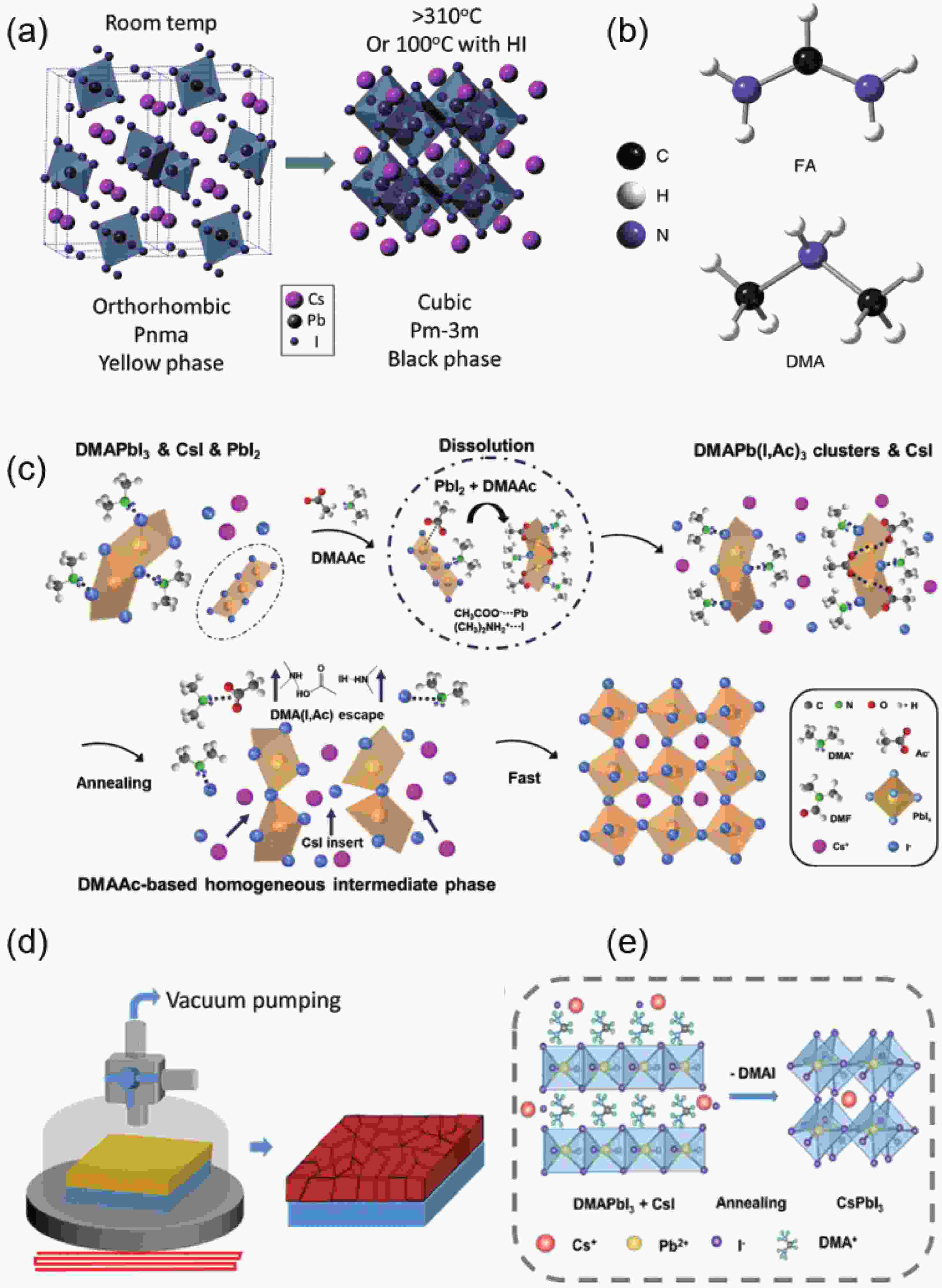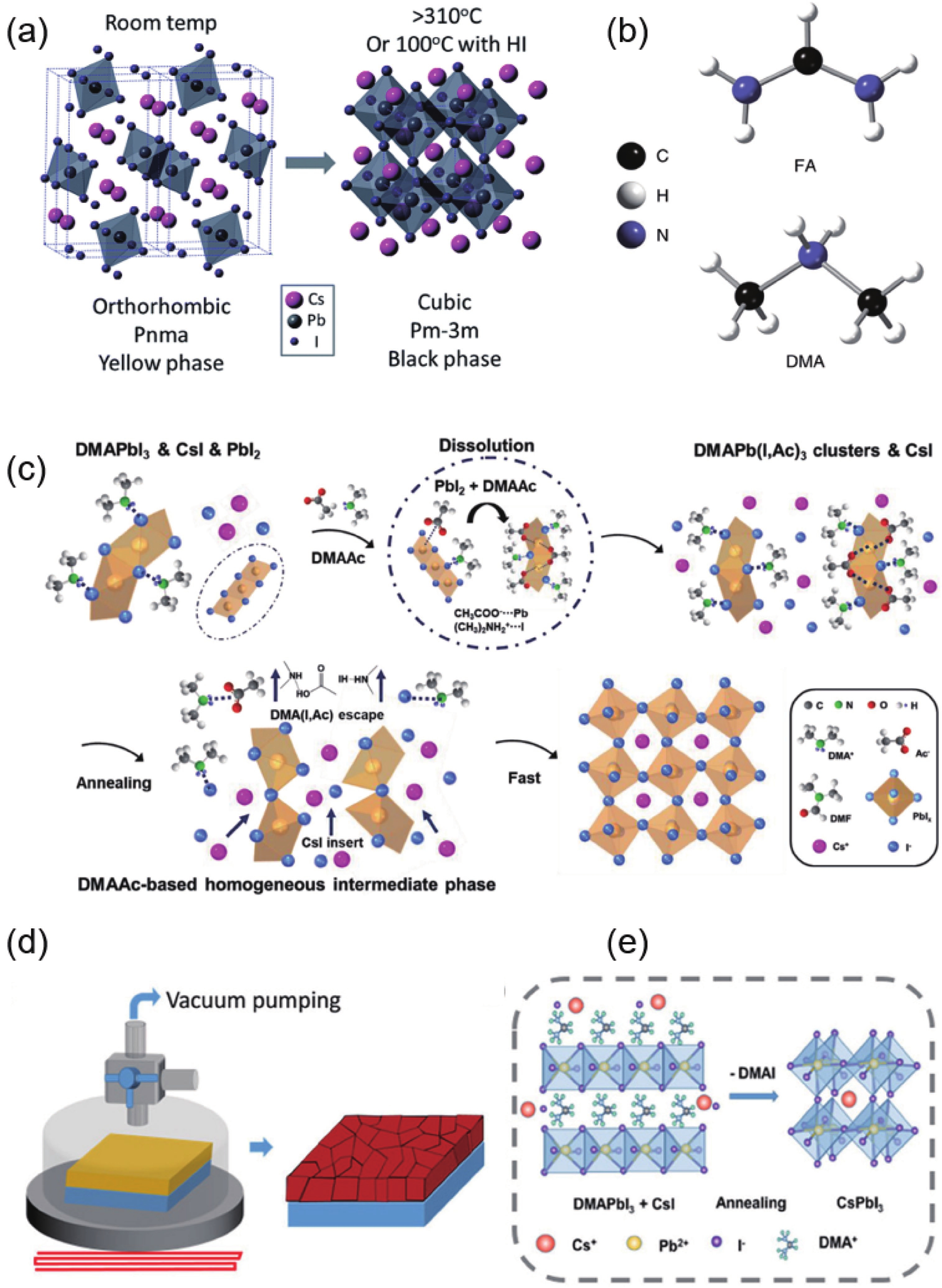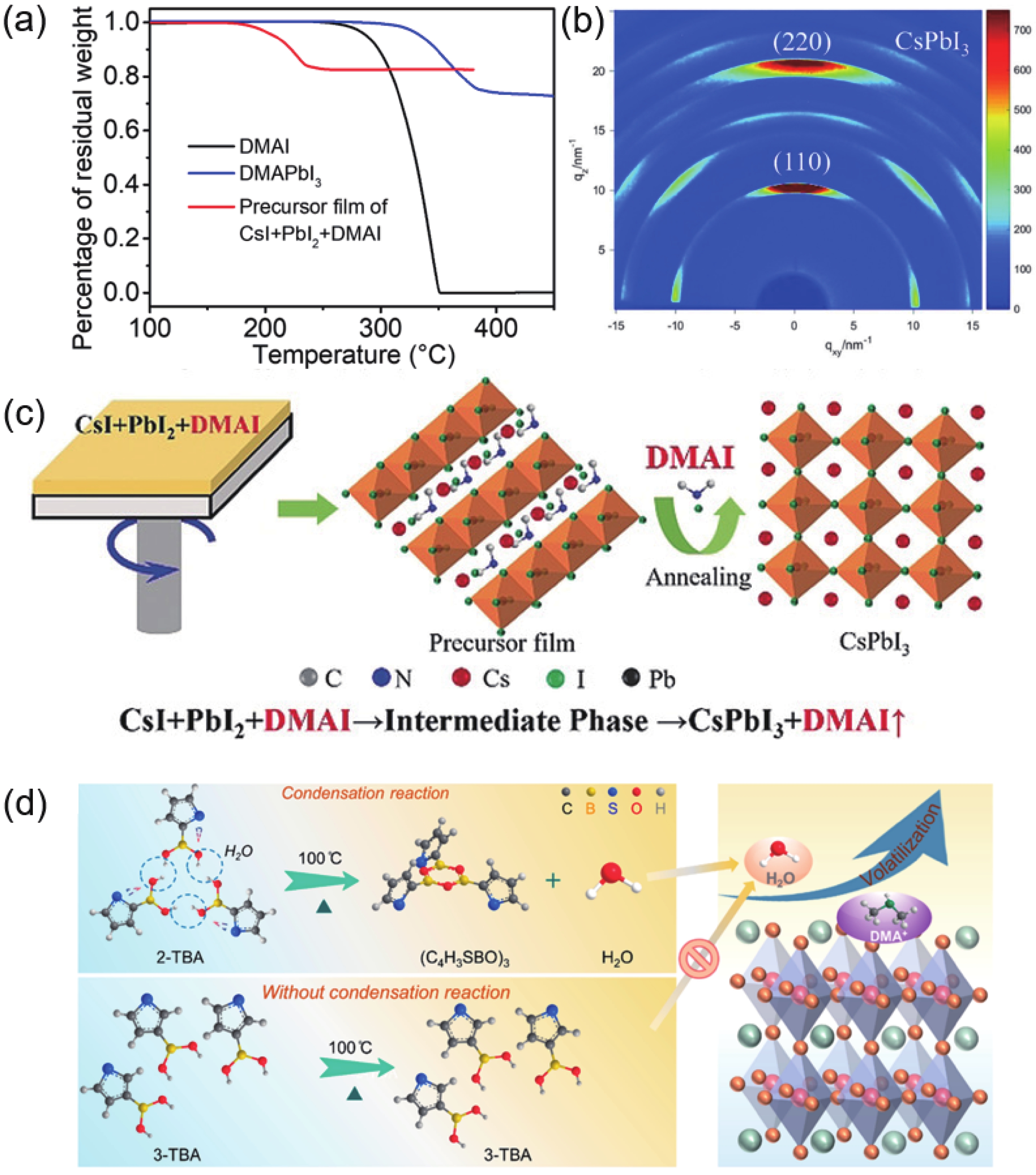| Citation: |
Zuolin Zhang, Mengjia Li, Jie Sun, Cong Chen, Jiangzhao Chen, Liming Ding. Dimethylammonium cation stabilizes all-inorganic perovskite solar cells[J]. Journal of Semiconductors, 2023, 44(3): 030202. doi: 10.1088/1674-4926/44/3/030202
Z L Zhang, M J Li, J Sun, C Chen, J Z Chen, L M Ding. Dimethylammonium cation stabilizes all-inorganic perovskite solar cells[J]. J. Semicond, 2023, 44(3): 030202. doi: 10.1088/1674-4926/44/3/030202
Export: BibTex EndNote
|
Dimethylammonium cation stabilizes all-inorganic perovskite solar cells
doi: 10.1088/1674-4926/44/3/030202
More Information-
References
[1] Yu G, Jiang K J, Gu W M, et al. Vacuum-assisted thermal annealing of CsPbI3 for highly stable and efficient inorganic perovskite solar cells. Angew Chem Int Ed, 2022, 61, e202203778 doi: 10.1002/anie.202203778[2] Wang H, Liu H, Dong Z, et al. Composition manipulation boosts the efficiency of carbon-based CsPbI3 perovskite solar cells to beyond 14%. Nano Energy, 2021, 84, 105881 doi: 10.1016/j.nanoen.2021.105881[3] Jia X, Zuo C, Tao S, et al. CsPb(I xBr1– x)3 solar cells. Sci Bull, 2019, 64, 1532 doi: 10.1016/j.scib.2019.08.017[4] Wang Y, Zhang X, Shi Z, et al. Stabilizing α-phase FAPbI3 solar cells. J Semicond, 2022, 43, 040202 doi: 10.1088/1674-4926/43/4/040202[5] Yuan Y, Yan G, Hong R, et al. Quantifying efficiency limitations in all-inorganic halide perovskite solar cells. Adv Mater, 2022, 34, e2108132 doi: 10.1002/adma.202108132[6] Li Z, Zhou F, Wang Q, et al. Approaches for thermodynamically stabilized CsPbI3 solar cells. Nano Energy, 2020, 71, 104634 doi: 10.1016/j.nanoen.2020.104634[7] Tian T, Yang M, Yang J, et al. Stabilizing black-phase CsPbI3 under over 70% humidity. J Semicond, 2022, 43, 030501 doi: 10.1088/1674-4926/43/3/030501[8] Wang K, Li Z, Zhou F, et al. Ruddlesden-popper 2D component to stabilize γ-CsPbI3 perovskite phase for stable and efficient photovoltaics. Adv Energy Mater, 2019, 9, 1902529 doi: 10.1002/aenm.201902529[9] Tian J, Xue Q, Yao Q, et al. Inorganic Halide perovskite solar cells: progress and challenges. Adv Energy Mater, 2020, 10, 2000183 doi: 10.1002/aenm.202000183[10] Wang Q, Zheng X, Deng Y, et al. Stabilizing the α-phase of CsPbI3 perovskite by sulfobetaine zwitterions in one-step spin-coating films. Joule, 2017, 1, 371 doi: 10.1016/j.joule.2017.07.017[11] Sanehira E M, Marshall A R, Christians J A, et al. Enhanced mobility CsPbI3 quantum dot arrays for record-efficiency, high-voltage photovoltaic cells. Sci Adv, 2017, 3, eaao4204 doi: 10.1126/sciadv.aao4204[12] Swarnkar A, Marshall A R, Sanehira E M, et al. Quantum dot-induced phase stabilization of α-CsPbI3 perovskite for high-efficiency photovoltaics. Science, 2016, 354, 92 doi: 10.1126/science.aag2700[13] Bai F, Zhang J, Yuan Y, et al. A 0D/3D heterostructured all-inorganic halide perovskite solar cell with high performance and enhanced phase stability. Adv Mater, 2019, 31, 1904735 doi: 10.1002/adma.201904735[14] Li Z, Sun Y, Yao H, et al. Intermediates transformation for efficient perovskite solar cells. J Energy Chem, 2021, 52, 102 doi: 10.1016/j.jechem.2020.04.047[15] Eperon G E, Paternò G M, Sutton R J, et al. Inorganic caesium lead iodide perovskite solar cells. J Mater Chem A, 2015, 3, 19688 doi: 10.1039/C5TA06398A[16] Kim Y G, Kim T Y, Oh J H, et al. Cesium lead iodide solar cells controlled by annealing temperature. Phys Chem Chem Phys, 2017, 19, 6257 doi: 10.1039/C6CP08177K[17] Zhang T, Dar M I, Li G, et al. Bication lead iodide 2D perovskite component to stabilize inorganic α-CsPbI3 perovskite phase for high-efficiency solar cells. Sci Adv, 2017, 3, e1700841 doi: 10.1126/sciadv.1700841[18] Yoon S M, Min H, Kim J B, et al. Surface engineering of ambient-air-processed cesium lead triiodide layers for efficient solar cells. Joule, 2021, 5, 183 doi: 10.1016/j.joule.2020.11.020[19] Yu B, Shi J, Tan S, et al. Efficient (>20 %) and stable all-inorganic cesium lead triiodide solar cell enabled by thiocyanate molten salts. Angew Chem Int Ed, 2021, 60, 13436 doi: 10.1002/anie.202102466[20] Lu C, Li X, Guo X, et al. Efficient inverted CsPbI3 perovskite solar cells fabricated in common air. Chem Eng J, 2023, 452, 139495 doi: 10.1016/j.cej.2022.139495[21] Cui Y, Shi J, Meng F, et al. A versatile molten-salt induction strategy to achieve efficient CsPbI3 perovskite solar cells with a high open-circuit voltage >1.2 V. Adv Mater, 2022, 34, e2205028 doi: 10.1002/adma.202205028[22] Jiang Y, Yuan J, Ni Y, et al. Reduced-dimensional α-CsPbX3 perovskites for efficient and stable photovoltaics. Joule, 2018, 2, 1356 doi: 10.1016/j.joule.2018.05.004[23] Huang Q, Liu Y, Li F, et al. Advances in cesium lead iodide perovskite solar cells: processing science matters. Mater Today, 2021, 47, 156 doi: 10.1016/j.mattod.2021.01.014[24] Bian H, Wang H, Li Z, et al. Unveiling the effects of hydrolysis-derived DMAI/DMAPbI x intermediate compound on the performance of CsPbI3 solar cells. Adv Sci, 2020, 7, 1902868 doi: 10.1002/advs.201902868[25] Ke W, Spanopoulos I, Stoumpos C C, et al. Myths and reality of HPbI3 in halide perovskite solar cells. Nat Commun, 2018, 9, 4785 doi: 10.1038/s41467-018-07204-y[26] Lee M V, Raga S R, Kato Y, et al. Transamidation of dimethylformamide during alkylammonium lead triiodide film formation for perovskite solar cells. J Mater Res, 2016, 32, 45 doi: 10.1557/jmr.2016.272[27] Pei Y, Liu Y, Li F, et al. Unveiling property of hydrolysis-derived DMAPbI3 for perovskite devices: composition engineering, defect mitigation, and stability optimization. iScience, 2019, 15, 165 doi: 10.1016/j.isci.2019.04.024[28] Gu X, Xiang W, Tian Q, et al. Rational surface-defect control via designed passivation for high-efficiency inorganic perovskite solar cells. Angew Chem Int Ed, 2021, 60, 23164 doi: 10.1002/anie.202109724[29] Sun X, Shao Z, Rao Y, et al. A Low-Temperature Additive-involved leaching method for highly efficient inorganic perovskite solar cells. Adv Energy Mater, 2020, 11, 2002754 doi: 10.1002/aenm.202002754[30] Jariwala S, Kumar R E, Eperon G E, et al. Dimethylammonium addition to halide perovskite precursor increases vertical and lateral heterogeneity. ACS Energy Lett, 2022, 7, 204 doi: 10.1021/acsenergylett.1c02302[31] Jung M, Ji S G, Kim G, et al. Perovskite precursor solution chemistry: from fundamentals to photovoltaic applications. Chem Soc Rev, 2019, 48, 2011 doi: 10.1039/C8CS00656C[32] Wang Y, Dar M I, Ono L K, et al. Thermodynamically stabilized β-CsPbI3-based perovskite solar cells with efficiencies >18%. Science, 2019, 365, 591 doi: 10.1126/science.aav8680[33] Wang Y, Liu X, Zhang T, et al. The role of dimethylammonium iodide in CsPbI3 perovskite fabrication: additive or dopant. Angew Chem Int Ed, 2019, 58, 16691 doi: 10.1002/ange.201910800[34] Chen Y, Liu X, Zhao Y. Organic matrix assisted low-temperature crystallization of black phase inorganic perovskites. Angew Chem Int Ed, 2022, 134, e202110603 doi: 10.1002/ange.202110603[35] Sun X, Shao Z, Li Z, et al. Highly efficient CsPbI3/Cs1– xDMAxPbI3 bulk heterojunction perovskite solar cell. Joule, 2022, 6, 850 doi: 10.1016/j.joule.2022.02.004[36] Liu Y, Li F, Gong J, et al. Low-temperature removal of residual dimethylammonium via surface molecular oligomerization for CsPbI3 perovskite solar cells. ACS Energy Lett, 2022, 7, 3227 doi: 10.1021/acsenergylett.2c01580[37] Meng F, Yu B, Zhang Q, et al. Ge incorporation to stabilize efficient inorganic CsPbI3 perovskite solar cells. Adv Energy Mater, 2022, 12, 2103690 doi: 10.1002/aenm.202103690[38] Ding Y, Guo Q, Geng Y, et al. A low-cost hole transport layer enables CsPbI2Br single-junction and tandem perovskite solar cells with record efficiencies of 17.8 % and 21.4 %. Nano Today, 2022, 46, 101586 doi: 10.1016/j.nantod.2022.101586 -
Proportional views






 DownLoad:
DownLoad:
















